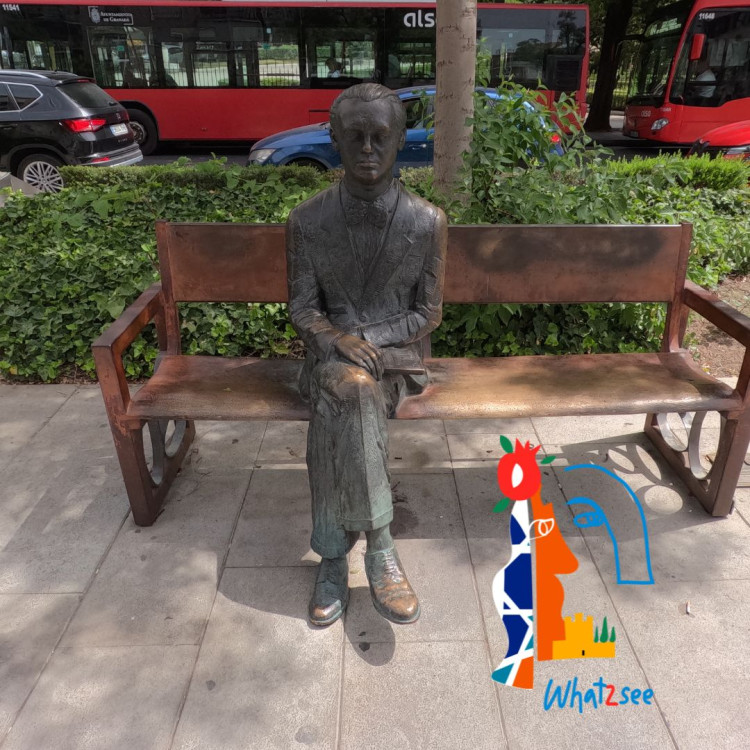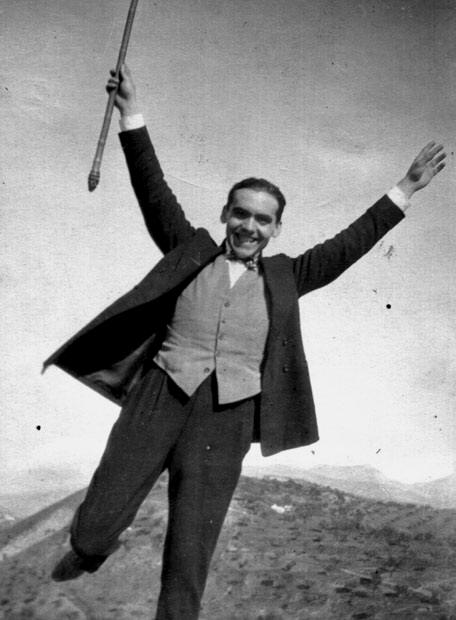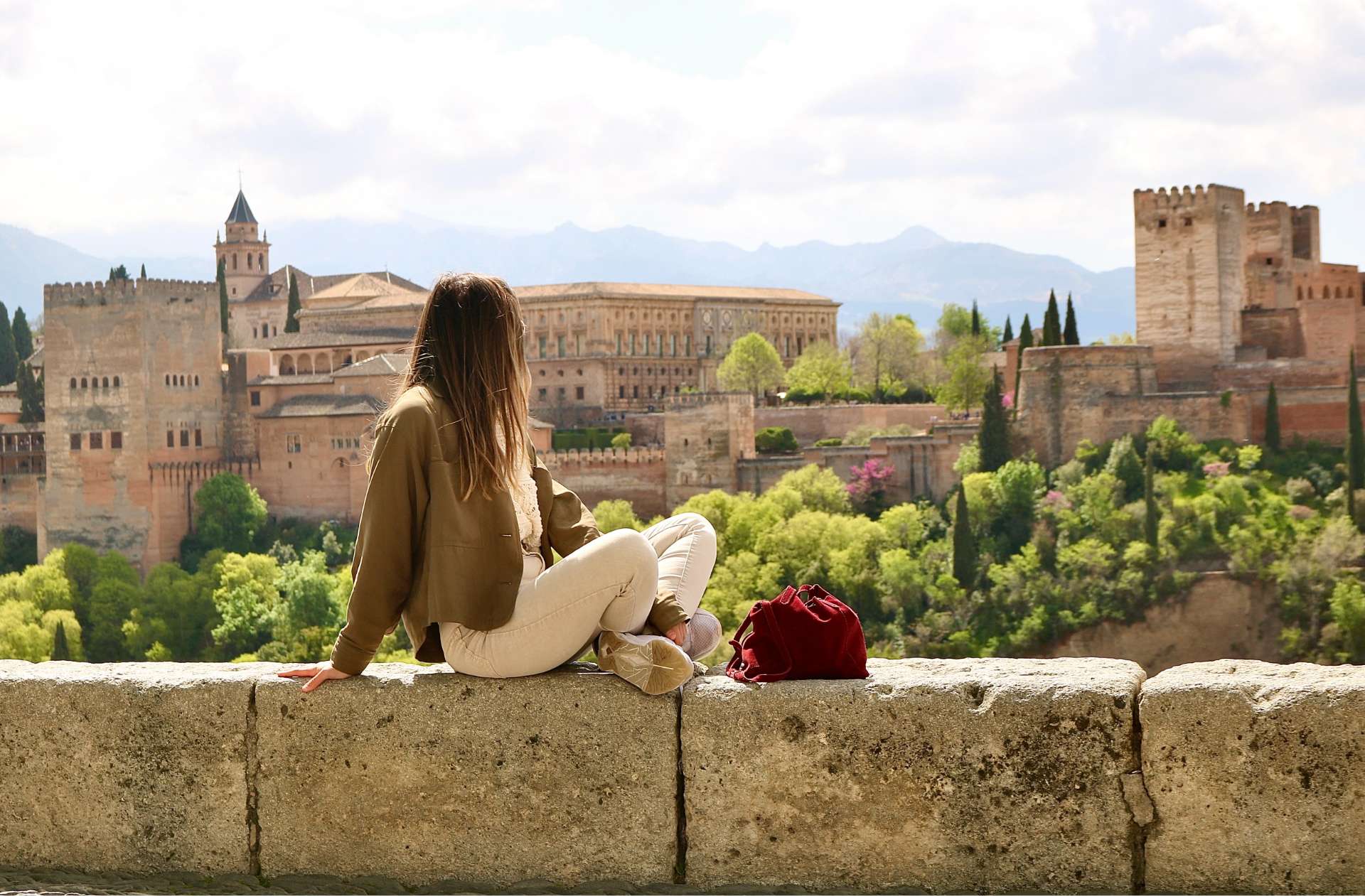In Lorca’s Footsteps in Granada: A Complete Route Through the Places of the Universal Poet

Granada cannot be understood without Federico García Lorca, nor can Lorca be understood without Granada. The city and its province are infused with the essence of the universal poet who found, in these streets, trails, and landscapes, the inspiration for
Lorca’s Must-See Spots in Granada (Interactive Map Included)
Before you lace up your shoes (and the comfier, the better!), open your interactive map and locate the Lorquian landmarks we’re about to explore. Because this isn’t just a cultural visit—it’s a journey into Federico’s soul! We’re about to wander through verses, pianos, literary gatherings, and gardens. Ready?
Birthplace in Fuente Vaqueros: Where It All Began
17 km from Granada lies the poet’s birthplace: Fuente Vaqueros. Federico was born here in 1898, and here he began to see the world with those childlike eyes he never really lost. The house-museum welcomes you with original furniture, endearing photos, and even the very room where he let out his first cry (or maybe his first verse).
Don’t miss:
The room where the poet was born
A collection of first editions of his works
The Andalusian courtyard where little Federico took his first steps
Original documents and family photographs
Opening hours: Tuesday to Sunday from 10:00 to 14:00 and 17:00 to 19:00 (summer hours)
Admission: General ticket €3 (check for discounts)
Curious traveler tip: If you close your eyes in the courtyard, you can almost see Federico running around with his little hat, making up stories for each flower.
Huerta de San Vicente: The Family’s Creative Refuge
The Huerta de San Vicente was the García Lorca family’s summer home from 1926 to 1936. If Fuente Vaqueros was the beginning, the Huerta was his creative lab, his retreat, his wellspring of inspiration. Here he wrote Blood Wedding and Yerma, as crickets chirped at sunset and the scent of tobacco filled the air. Today, this spot is a museum set in a park that embraces you with silence and beauty.
Highlights:
The bedroom-office where Lorca wrote
The family piano where he composed and played
The garden that so often inspired his work
Temporary exhibitions about his life and legacy
Opening hours: Tuesday to Sunday from 10:00 to 14:30 and 17:00 to 19:30
Admission: General ticket €3 (check for discounts)
Bonus: Visit in the late afternoon, when the sun filters through the trees—time seems to stand still. Truly magical.
Federico García Lorca Center: Literary Legacy in the Heart of Granada
Right in the center of Granada, in Plaza de la Romanilla, stands this modern temple devoted to Lorca’s legacy. The Federico García Lorca Center is like a treasure chest: it houses manuscripts, drawings, personal objects, and even theatre programs. But it’s also a living space, with cultural activities, exhibitions, and performances.
Highlights:
An archive with original manuscripts, drawings, and personal documents
A library specializing in Lorca’s work
Temporary exhibitions focused on the poet and his world
A packed cultural calendar (readings, plays, lectures)
Opening hours:
Tuesday to Saturday from 11:00 to 14:00 and 17:00 to 20:00
Sundays and public holidays from 11:00 to 14:00
Admission: Check depending on exhibitions and events
Pro tip: Check their calendar before your visit—you might catch a live poetry recital or a play!
Café Alameda and the Literary Gatherings: Lorca’s Social Granada
Although the original Café Alameda no longer exists, its bohemian spirit lives on in every café along the Acera del Casino. It was here that Lorca debated, laughed, and created alongside his intellectual companions: Manuel de Falla, Hermenegildo Lanz, Manuel Ángeles Ortiz…
Recommended experience:
Grab a coffee at one of the cafés near the original location
Visit the nearby Hotel Reina Cristina, where Lorca held readings and forged lasting friendships
Stroll through the Jardines del Salón and let yourself be inspired by the echoes of conversations that shaped a generation
Lorca’s Fragments: Poetry in Every Corner of Granada
Granada is not just a place; it is a state of the soul. A city that breathes poetry in every corner, in every shadow cast by its minarets, in every fountain that murmurs like a secret verse. Federico García Lorca knew how to capture that essence like no one else and turn it into living literature. In his hands, Granada became a symbol, a myth, an eternal stage where the Andalusian soul is both sung and mourned.
To explore Granada through Lorca’s eyes is to discover a parallel city—a place where every street corner is a poem waiting to be read. Here we present three of its most emblematic spots, places that not only inspired the poet but were also transformed by him into timeless spaces.
The Alhambra and the Generalife
"Alhambra, jasmine of sorrow, where the moon comes to rest"
The Alhambra is not just an architectural jewel—it is a symbolic universe. For Lorca, this Nasrid palace was a place where history merged with mystery, where beauty was bathed in the melancholy of time. The gardens of the Generalife, with their constant whisper of water, evoked in him a sensual, almost dreamlike world.
Water, ever-present in the Alhambra, is also one of Lorca’s most powerful symbols: life that flows, desire that slips away, death that lurks in stillness. It is no coincidence that in many of his poems, water sings, cries, flows, or stops as a vital metaphor.
Don’t miss:
Strolling through the Court of the Myrtles while reading Poet in New York, where nostalgia for the Alhambra becomes universal.
The Albaicín
"Oh city of the gypsies! Who saw you and does not remember you?"
If there is one neighborhood that embodies the Lorquian spirit, it is the Albaicín. With its narrow alleyways, its scent of jasmine, and its Moorish soul, this quarter is pure metaphor. In its hidden cármenes and breathtaking views of the Alhambra, Lorca found the essence of the people, of blood, of the moon.
In his Gypsy Ballads, the Albaicín becomes a stage for impossible loves, burning passions, and almost ritual tragedies. The neighborhood is feminine, mysterious, sensual. It is both mother and lover. It is deep Granada, unmasked.
What to do:
Climb to the Mirador de San Nicolás while whispering his ballads—let the echo do the rest.
Get lost without a map, guided only by verses in your mind, and let the Albaicín lead the way.
The Sacromonte
"You will see her dance between lights and guitars—Carmen la Granadina"
And if the Albaicín is the soul, the Sacromonte is the heartbeat that pulses to the rhythm of bulería. This white hillside, dotted with caves and lit by moonlight, was an endless source of inspiration for Lorca. Here lived the gypsy Granada—the one that sang and wept with equal intensity, that saw art as a way of life and pain as part of the cante.
Lorca captured that pulse and raised it to myth. In his works, flamenco is not just music—it is catharsis. Sacromonte becomes a living theater, where passion drags across the floor and tragedy is sung with a broken voice. Here, Carmen is not just a name—she is an archetype, a suffering and overflowing muse.
To feel it:
Attend a flamenco show in an authentic cave, with a glass of wine in hand and your senses wide open.
Walk the Vereda de Enmedio at sunset, looking down on Granada and letting the city tell you its story through cante jondo.
Lorca didn’t just write about Granada—he reinvented it. He turned its streets into verses, its people into characters, its landscapes into symbols. Today, walking through the city is like stepping into a grand poetic work where every corner whispers fragments of his legacy.
So don’t just look with your eyes. Look with your soul. Listen with your heart. Because Granada is still speaking to Lorca… and if you pay attention, it will speak to you too.
Secrets and Anecdotes: The Poet’s Intimate Granada
Beyond monuments and official routes, there lies a hidden and personal Granada—woven from encounters, laughter, music, and confidences. It is the city Federico García Lorca lived in, loved, and shared with his closest friends. A Granada that kept his secrets tucked away among cármenes, cafés, gatherings, and gardens.
Discovering this intimate side of the poet is like opening his personal diary and walking through a city filled with echoes of piano music, flamenco voices, passionate conversations, and endless nights. Here are some of the places and memories that still whisper his name.
A Friendship with Duende: Lorca and Manuel de Falla
Few relationships were as decisive for Lorca’s artistic life as his friendship with composer Manuel de Falla. Two geniuses with different sensibilities, united by a shared passion: to rescue the deep soul of Andalusian folk art—especially the purest flamenco, cante jondo.
In 1922, they organized the first Cante Jondo Contest in the Plaza de los Aljibes of the Alhambra—an event that marked a turning point in the recognition of flamenco, which had long been dismissed by academic circles. Lorca wrote texts for the program and recited poems inspired by the music, while Falla propelled the musical side from its roots.
Where to relive it:
Visit the Manuel de Falla House-Museum, located in Antequeruela Alta, near the Alhambra. This former residence preserves scores, manuscripts, and objects that transport you to the time when both artists dreamed of elevating Andalusian art from their corner of Granada.
The Carmen of Literary Gatherings: Rodríguez-Acosta
In the heart of the Realejo district, the carmen of the Rodríguez-Acosta family was one of the most vibrant cultural hubs of its time. It was not merely a house with a garden—it was an intimate stage where Federico gave free rein to his creativity.
Here, he would read his unpublished poems aloud, play his favorite piano pieces, or improvise short theatrical performances. It was a free-spirited, bohemian space where artists, writers, and musicians shared ideas during evenings filled with wine, conversation, and art.
Although the original carmen is not open to the public, its spirit lives on in the nearby Rodríguez-Acosta Foundation—a magical place where art, architecture, and memory converge.
Tip:
Linger in the garden of the Foundation and let your imagination transport you to one of those Granadian nights when Lorca, amid laughter and lanterns, recited verses under the stars.
La Venta de Eritaña: A Refuge of Nature and Poetry
Not everything in Lorca’s life revolved around salons and soirées. He also needed spaces for retreat and escape. One of his favorite hideaways was the legendary Venta de Eritaña, a rustic eatery on the outskirts of Granada, often frequented by intellectuals and artists.
There, with simple dishes and red wine, the poet found the calm of the countryside, the whisper of poplars, and the voice of the people. Many of his walks with friends started from this spot, filled with laughter, improvisation, and heartfelt conversation. It was his way of recharging—far from academic noise, close to the land’s true rhythm.
Today:
Though the venta no longer exists, its spirit lives on in the surroundings of the current Federico García Lorca Park—a perfect place to stroll and connect with the poet’s more contemplative side. There you’ll also find the Huerta de San Vicente, the Lorca family’s summer house, and another essential stop in this intimate Granada.
Practical Itinerary: How to Organize Your Lorca-Inspired Route in One (or Two) Days
To make the most of your journey in Lorca’s footsteps, we suggest a well-organized itinerary that will let you visit the most important places without stress and with enough time to truly enjoy each stop.
One-Day Itinerary (intensive)
Morning:
10:00 – Birthplace in Fuente Vaqueros
12:00 – Transfer to Granada
13:00 – Federico García Lorca Center
14:30 – Lunch in the city center (Tip: try a traditional tavern near Plaza Nueva)
Afternoon:
17:00 – Huerta de San Vicente
19:00 – Walk through the Albaicín and Sacromonte neighborhoods
21:00 – Dinner with flamenco show (to feel the Granada that inspired Lorca)
Two-Day Itinerary (recommended for savoring every verse)
Day 1:
Morning – Birthplace and the Valderrubio House-Museum
Afternoon – Huerta de San Vicente and stroll through the historic center
Day 2:
Morning – Federico García Lorca Center and nearby urban landmarks
Afternoon – Albaicín, Sacromonte, and sunset at the San Nicolás viewpoint
Practical Tips:
Book guided visits to the Huerta de San Vicente in advance
Use public transport or rent a car to reach Fuente Vaqueros
Wear comfortable shoes for walking through Albaicín and Sacromonte
Where to Stay to Follow Lorca’s Footsteps in Granada
Choosing the right place to stay can transform your Lorca-inspired journey into a true emotional immersion. The city opens like a stage, where each neighborhood holds its own verse—its own unique way of connecting you to the life and work of Federico García Lorca. Here are some key areas and recommendations so you can find the accommodation that best suits your way of experiencing Granada: from the cultural bustle of the city center to the tranquility of its historic quarters.
Historic Center: The Literary Heart
If you want everything within walking distance, Granada’s city center is your best bet. Here you’ll find the Federico García Lorca Center, located in Plaza de la Romanilla, home to exhibitions, original documents, manuscripts, and a theater where his legacy still lives and breathes. From here, you can walk to many other Lorca-related spots, like Plaza Bib-Rambla, the Cathedral, or Calle Mesones, where Federico spent many afternoons.
Ideal for: Travelers seeking comfort, proximity to cultural hotspots, and a wide range of food and entertainment options.
Recommendations:
Hotel Reina Cristina: More than just accommodation—it’s a piece of history. Lorca stayed here several times and even held private poetry readings. The hotel preserves some original furniture and a charming period atmosphere.
Albaicín: The Granada of Poems
Staying in the Albaicín is like sleeping inside one of Lorca’s verses. This Moorish quarter, with its cobblestone streets, whitewashed houses, blooming patios, and breathtaking viewpoints, was a constant source of inspiration for Lorca. Here he wrote about gypsy women, moons, daggers, and impossible loves. It’s the ideal choice if you’re looking for a picturesque, authentic, and deeply symbolic experience.
Ideal for: Dreamers, romantics, photography lovers, and wanderers.
Recommendations:
Traditional cármenes turned into tourist lodgings: Many of these historic homes offer private gardens, Alhambra views, and the magical silence of Albaicín evenings.
Near García Lorca Park: The Poet’s Everyday Calm
If you want to be close to the more personal and family-oriented side of Lorca, nothing beats staying near Federico García Lorca Park, where the poet’s summer house—Huerta de San Vicente—is now a museum. Here, he wrote works like Blood Wedding, and the house still preserves his piano, desk, garden full of geraniums… and his soul.
Ideal for: Travelers looking for tranquility, everyday Granadan life, and easy connections to the rest of the city.
Recommendations:
Tourist apartments: Comfortable, well-equipped, and perfect for longer stays. Some are even decorated with touches inspired by classic Granada.
Mid-range hotels in the Camino de Ronda or Arabial area, offering good value for money and direct transport to the historic center or the Alhambra.
Staying in Granada while following Lorca’s footsteps is not just about choosing a location—it’s a way of feeling the city from within, of hearing it breathe between verses, of seeing through the same windows, strolling through his favorite squares, and waking up under the same sky that so often inspired his work.
Each neighborhood shows you a different side of Granada, but they all share one thing: the ever-present spirit of the poet. Let his memory guide your journey, and may his words accompany you as you explore the corners of the city that still pulse with his voice.
“Green, how I want you green. Green wind. Green branches.
The ship on the sea and the horse on the mountain…”
Pack your bags. Put on your most comfortable shoes.
And come live Lorca’s Granada—with its light, its shadows, and its magic.
Are you ready to feel like he did?
Then dive into an experience more intense than a poem:
book our specialized tour, and let the Genil run through your veins.
https://www.what2seegranada.com/en/tours/en-personne-cicuit-lorca





